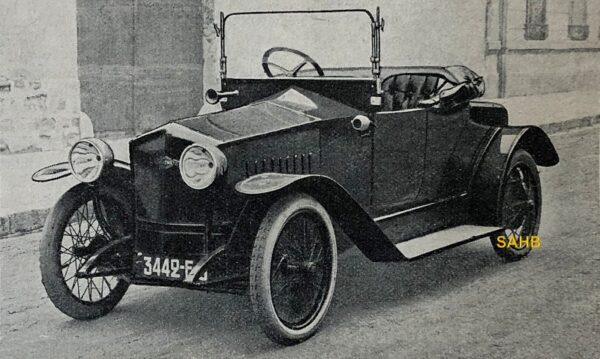
An article in the French automobile magazine Omnia in October 1922 discussed the advantages and limitations of the electric car. One significant point related to World War I: hydroelectric power was developing in France, thus lowering the cost of electricity per kilowatt hour, but as a result of the war the price of petrol quintupled. More thought was therefore given to using electric power in cars.
One French example of this revival of interest in battery-electric propulsion was the S.A.T.M.E. (Société d’Appareils de Transports et de Manutentions Électriques), a light two-seater electric car with a dummy bonnet fronted by an imitation radiator – presumably to reassure potential customers that their choice of car would not be too outlandish.
The drivetrain was simple: a four-horsepower motor amidships (roughly where a conventional gearbox would be) drove through a propeller shaft to a differential with a final drive gearing of 13/54. The car was sprung by semi-elliptics all round. The lead-acid batteries were all around the car: the biggest grouping was under the bonnet, with more under the seat and two more on either side of the differential. The total of 28 two-volt batteries in series gave 56 volts and a capacity of 200 ampère-hours. The range was not given, but ignoring efficiency losses the battery would give 4 horsepower for 3.75 hours – not a bad result for a car presumably intended as a runabout in an urban environment.
Georgano states that the company only existed between 1922 and 1923, but a photograph of a three-wheeled delivery vehicle has been unearthed that looks to be older, with some sources suggesting 1912. This same vehicle, with the electric motor perched vertically above the single front wheel, with tiller steering and with the box body over the twin rear wheels, appeared in an advertisement for S.A.T.M.E. The advertisement mentioned 300kg carrying capacity, two forward speeds giving 18 and 30 km/h, reverse, steering by tiller or steering wheel, and lead-acid or ferro-nickel batteries. It could be bodied for delivery or as a town car.
Nothing more seems to have been heard of this company.
Image courtesy of The Richard Roberts Archive: www.richardrobertsarchive.org.uk







Leave a Comment